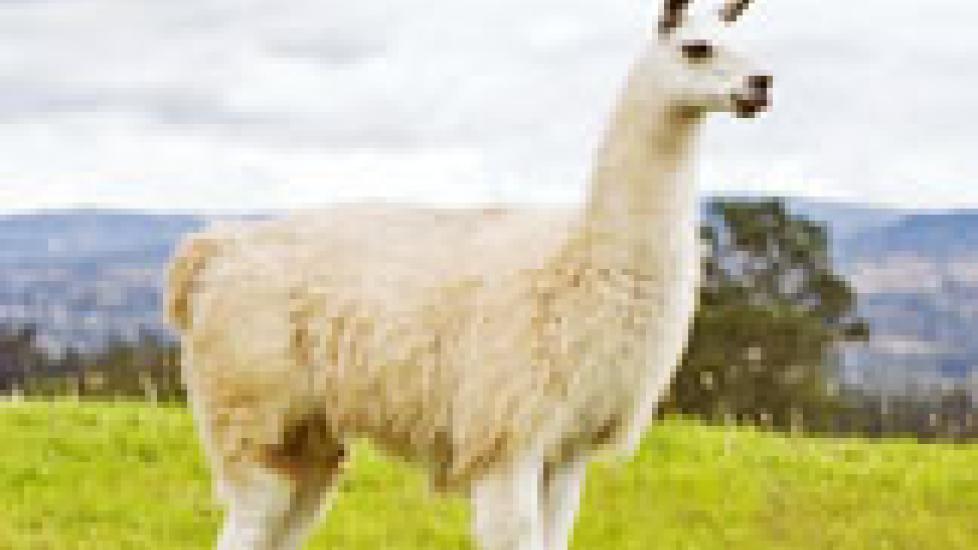Thinking Beyond the Dog: Guard Llamas
Today I’d like to tell you folks about a neat niche industry that I wasn’t aware of until I started practicing: guard llamas. I first came across a guard llama at a client’s alpaca farm. Amongst the alpacas, I spied a much taller, and much more serious, llama. Thinking he was just a fellow camelid, I was quickly corrected by his owner. “That’s our guard llama.”
Guard llama? Who ever heard of such a thing?
As it turns out, guard llamas are commonly employed out west on sheep and goat farms where predation, especially from coyotes and feral dogs, is a major problem. Alpaca farms, although much smaller venues than sheep farms on the range out west, also have problems with canids, usually in the form of neighbors’ unleashed dogs.
So why pick a llama over a guard dog, with breeds tailored specifically for guarding livestock, such as the Great Pyrenees, Komondors, Akbash, and Anatolian Shepherds? As it turns out, there are many great reasons. Llamas are naturally aggressive toward coyotes and dogs. If they see a predator, they will make a distinctive alarm call and will either run after the predator or gather the flock and stand between the flock and the predator. Although llamas may lack the snarling, growling appearance of an aggressive guard dog, the image of a 600-pound llama running in your direction with ears back should be enough to discourage intrusion!
In 1990, researchers from Iowa State University surveyed sheep farmers in Montana, Wyoming, Colorado, California, and Oregon regarding their experiences with guard llamas. Respondents reported an average loss of 21 percent in sheep annually before getting a llama, and 7 percent loss afterwards. Eighty percent of the respondents considered their guard llamas as “effective” or “very effective.”
Other than being good at their job, guard llamas have other perks. Firstly, they don’t need to be specifically trained as a guard animal nor do they need to be raised with sheep, as guard dogs require. Llamas aren’t as susceptible to traps and poisons as guard dogs are given their size and generally less inquisitive nature, and “accidents,” meaning a guard animal going after the animals he is supposed to be protecting, are virtually non-existent. Additionally, llamas can eat the same feed as the sheep, be treated with the same medications, vaccinated and dewormed the same way, and can live out on pasture with the sheep. Llamas also have longer life spans than dogs of any breed, frequently living over twenty years.
Donkeys are also sometimes used as guard animals and have most of the same perks as guard llamas over guard dogs, although donkeys are less popular than llamas in this pursuit. Although some donkeys are aggressive to dogs and coyotes, others are complacent, so choosing the right kind of donkey is important for the job at hand.
It is recommended that only one llama be used to protect a flock. A group of llamas will often form their own “clique” and ignore the sheep, goats, or alpacas, which is obviously not conducive to protecting them. Being herd-oriented animals, using a single llama entices him to understand that the sheep/goat flock is now his own herd, and the large size disparity between the llama and the small ruminants encourages dominance in the llama. There are many reports of guard llamas out west becoming very bonded to the small ruminants that they guard.
My first experience with a guard llama gave me the impression he was just a freeloader. He didn’t appear “on guard” or vigilant. In fact, he looked a little too laidback. I was skeptical. However, at a visit to another alpaca farm, while taking care of some young stock, I heard a noise. Inquiring what it was, the client looked up and explained it was the guard llama and that he had heard something so he was raising the alarm. I looked over my shoulder and sure enough, I could see the llama at the perimeter of the pasture, ears up, pacing back and forth, his attention completely centered on whatever was in the woods beyond the fence.
After that, my opinion changed. I was impressed. Guard llamas? Yes, now I’ve heard of them. And I’m a fan.

Dr. Anna O’Brien
Image: Justin Black / Shutterstock
